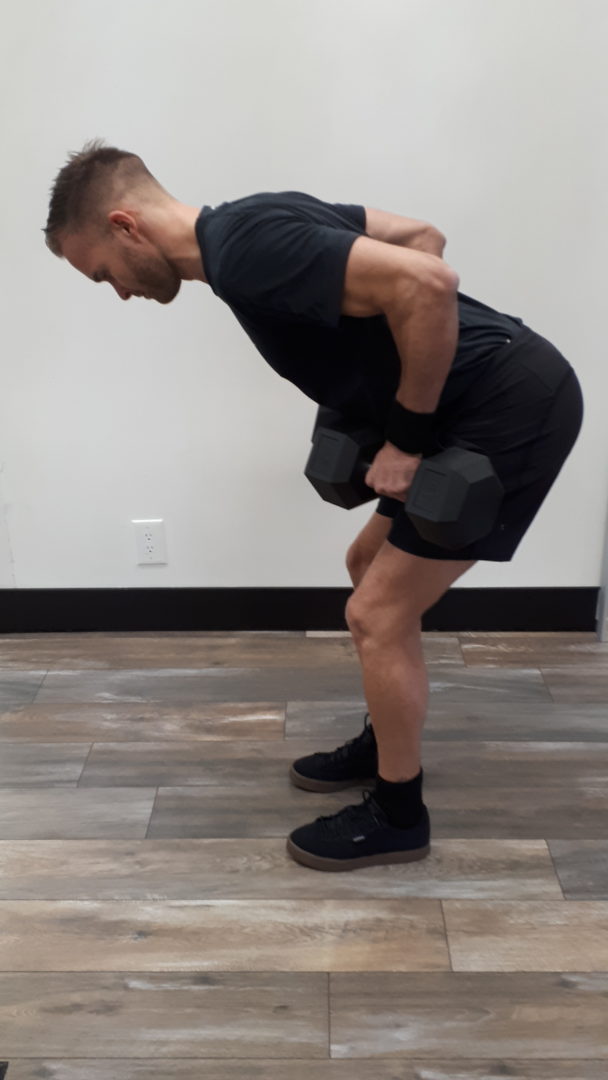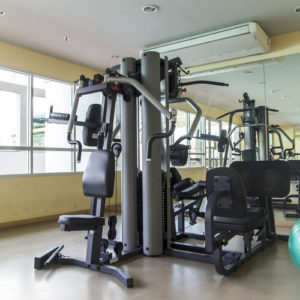Dumbbell Bent Over Row
Relevancy, Function and Execution
The dumbbell bent over row is possibly one of the most relevant and functional exercises as it mimic everyday life movement patterns such as lifting grocery bags from the cart or a baby from a carriage.
How to….
Start by using of a dowel or broomstick, ensuring your client’s posture is properly aligned to avoid slouching. Place the stick on your client’s back noting the three connection points, head, shoulders and hips are all touching the dowel.
Bend the knees slightly, then hinge slightly forward at the hips, keeping the spine in neutral position with the three contact points intact. Let the arms hang straight down while holding the dumbbells and maintain a contracted (tight) core.
Start the movement with a wide-arm motion, extending the arms out to the sides and ensuring the upper back muscles are contracted and the scapulas are retracted.


Variations
An alternative movement pattern is to lift the dumbbells at an oblique angle; this angle is narrower than the wide-arm motion as it requires the lifter to bring the elbows slightly closer to the body (45* angle in relation to the body)
Another variation of the movement is to keep the arms moving close to the body, but many mistakes are made with this particular angle. You must remember that this is a gravity oriented exercise, so ensure that the forearm is completely vertical and NOT angled forward. Angling the forearm forward engages your biceps and anterior deltoids whereas in the correct position, the focus will be on the upper back muscles.
Maintaining a forward angle at your elbow ensures that the line of pull (resistance line) is consistent with the angle of the body and the muscles that need to be targeted.
Synergist and Bio Mechanics
Going further into the kinesiology of this particular exercise prescription, the Bicep muscles are quite often a strong synergist to the movement mechanics of a bent-over row in order to assist the effectiveness of the overall movement.
In order to maximize one’s results for a stronger upper/mid back, the proper biomechanics in a bent-over row requires one to control the momentum of the movement and to utilize gravity to their advantage.
Momentum: Using momentum in a movement minimizes the full contraction force potential of the muscle which will decrease the training effect.
Gravity: More tension on the upper/mid back muscles is utilized when the weight and joint angle of the elbow is directly in line with the pull of gravity which will increase the training effect.
Athletic Performance Breathing
Breathing powerfully has a lot to do with your athletic performance as well as your quality of life. The way you breathe affects every system in your body (cardiovascular, nervous, endocrine, lymph, immune, digestive, and of course, respiratory). Breathing properly can decrease stress and muscle tension; calm your nerves; sharpen your focus; minimize negative and distracting thoughts; reduce fatigue; and promote stamina. Unfortunately, proper breathing is often an overlooked component of athletic training.
By André Noël Potvin, M.Sc, CES, CSCS, BCRPA-TFL, is a Clinical Exercise Specialist and Owner of Infofit, North America’s #1 School for Fitness Professionals.
-
 Weight Training 101$309.75
Weight Training 101$309.75

